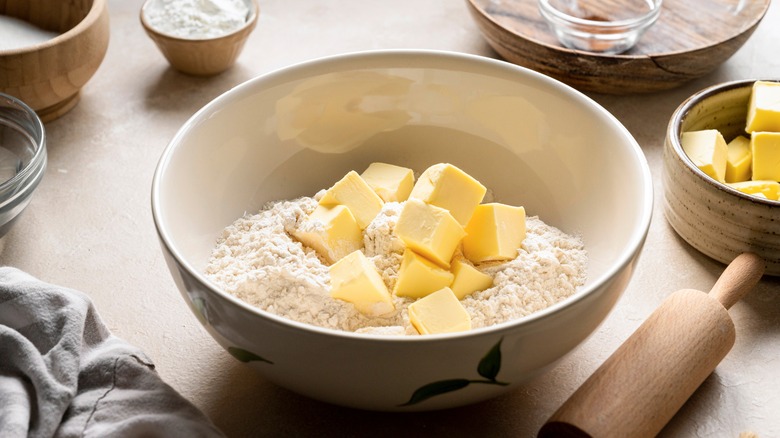The Easy Butter Method For Extra Flaky Pie Crust
When you want a pie, you aren't just coming for the filling; you're craving that extra flaky pie crust. The crust isn't just part of the pie; it's what makes it a pie in the first place. The buttery, crispy shell transforms apples and pumpkins into the desserts people spend generations passing down. If you love pie as much as you should, then you know getting a good crust means you should be making your own. That may sound intimidating, but pie crust falls on the relatively simple side of the pastry difficulty scale.
According to Serious Eats, you can be a lot more fast and loose with your pie crust than you might think. The primary keys are learning your preferred ratio of water and butter to flour, keeping things cool, so the fat doesn't melt, and that is pretty much it. Overworking your dough can lead to developing too much gluten, but having enough butter in your dough will offset that, so you shouldn't worry too much. And when it comes to incorporating that butter, there is an easy-to-remember method that delivers excellent results and can be pulled off by even the most inexperienced bakers.
Flattening small hunks of butter for flaky pie crust
The flake you want from a good pie crust comes from layers, and those layers come from fat, preferably butter. As Bon Appétit notes, when the butter in a pie crust heats in the oven, it lets out steam, which creates the air pockets that give your crust its layers. Butter that gets too warm and melts before it hits the oven or gets ground down into tiny pieces will combine with the flour and prevent those air pockets from forming, leaving you with tougher dough. So maintaining the right temperature and the size of your butter is critical. When you roll out your dough, you want to see visible pieces of butter dotted throughout.
Thankfully incorporating butter into your pie dough can be done quickly by hand. According to King Arthur Baking, you want to add your cold butter in two batches after cutting it into cubes. The first should be worked into the flour until it's pea-sized, and the second can just be mashed with your fingers into larger disks. This mixes a small amount of butter into the dough for tenderness but still maintains whole butter pieces in various sizes to give your crust that perfect, flaky texture. Sometimes it doesn't take a complicated recipe or expert technique to produce the best version of something; it just takes a few minutes and your fingers.

